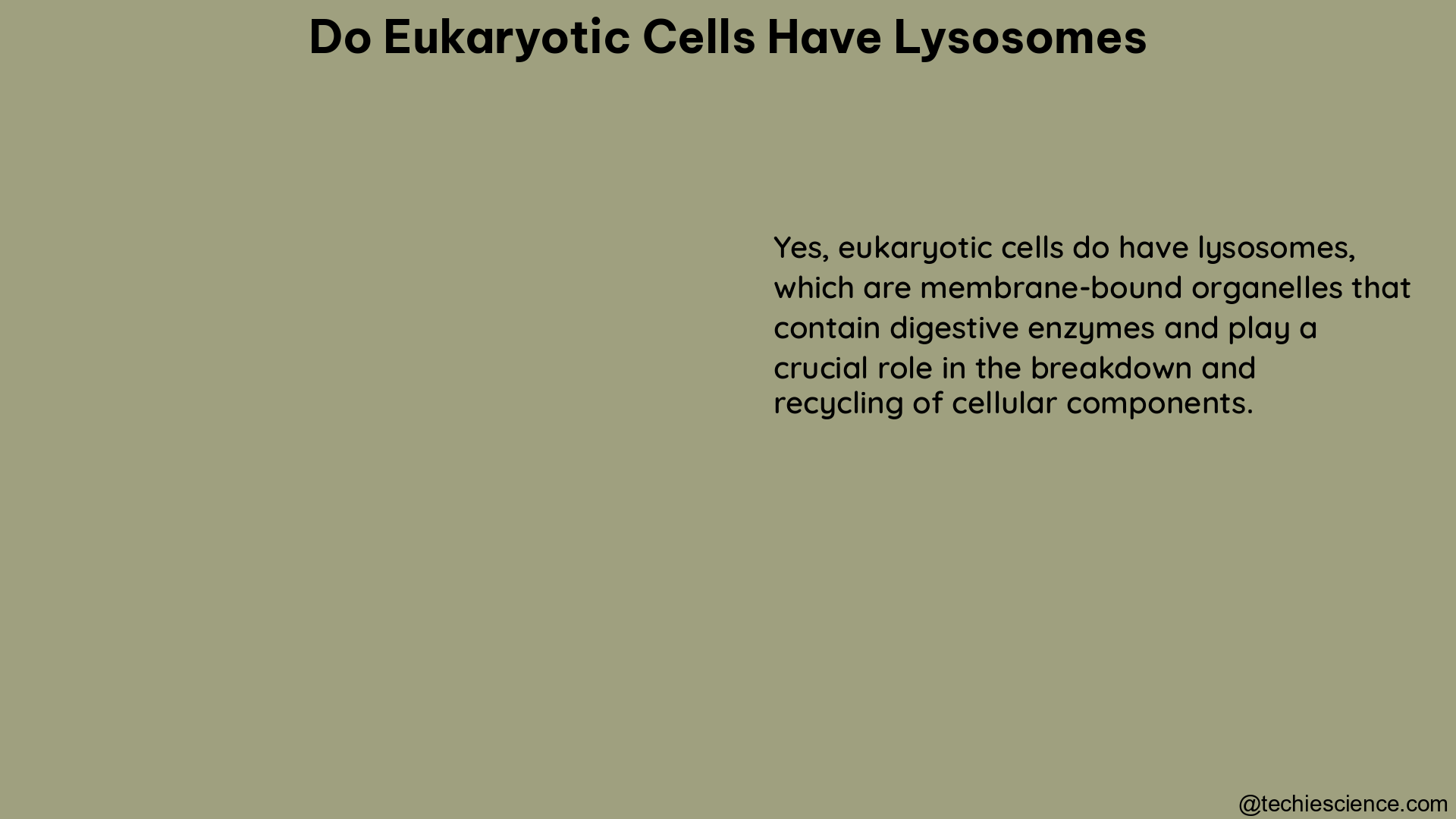Eukaryotic cells do have lysosomes, which are membrane-bound organelles found in every eukaryotic cell. Lysosomes are widely known as terminal catabolic stations that rid cells of waste products and scavenge metabolic building blocks that sustain essential biosynthetic reactions during starvation. They play a crucial role in nutrient sensing, transcriptional regulation, and metabolic homeostasis, elevating them to a decision-making center involved in the control of cellular growth and survival.
The Discovery and Identification of Lysosomes in Eukaryotic Cells
The discovery of lysosomes dates back to the 1950s when Christian de Duve, a Belgian biochemist, identified these organelles through a series of experiments using differential centrifugation techniques. De Duve and his colleagues found that certain hydrolytic enzymes, such as acid phosphatase, were concentrated in a specific subcellular fraction, which they named “lysosomes” (from the Greek words “lysis” meaning to break down, and “soma” meaning body).
Subsequent studies have revealed that lysosomes are present in all eukaryotic cells, including plant, animal, and fungal cells. The size and number of lysosomes can vary depending on the cell type and its metabolic state. For example, liver cells and macrophages typically have a higher number of lysosomes compared to other cell types, reflecting their increased catabolic activity.
Lysosomal Composition and Structure

Lysosomes are composed of a single lipid bilayer membrane that encloses a diverse array of hydrolytic enzymes, including proteases, lipases, nucleases, and glycosidases. These enzymes are optimally active in the acidic environment (pH 4.5-5.0) maintained within the lysosomal lumen, which is achieved through the action of proton pumps and chloride channels.
The lysosomal membrane also contains various transport proteins that facilitate the import of substrates and the export of degradation products. Additionally, lysosomes possess a unique set of membrane proteins, such as lysosome-associated membrane proteins (LAMPs) and lysosomal integral membrane proteins (LIMPs), which play crucial roles in maintaining the structural integrity and functional properties of these organelles.
Lysosomal Functions in Eukaryotic Cells
Lysosomes are responsible for a wide range of cellular functions, including:
-
Degradation and Recycling: Lysosomes break down macromolecules, such as proteins, nucleic acids, carbohydrates, and lipids, through the action of their hydrolytic enzymes. This process provides the cell with essential building blocks for the synthesis of new biomolecules, a process known as “autophagy.”
-
Waste Disposal: Lysosomes serve as the primary disposal site for cellular waste, including damaged organelles, misfolded proteins, and foreign materials, such as bacteria and viruses.
-
Nutrient Sensing and Signaling: Lysosomes play a crucial role in nutrient sensing and the regulation of cellular metabolism. They act as signaling hubs, integrating information about the cell’s nutrient status and triggering appropriate transcriptional and metabolic responses.
-
Membrane Repair: Lysosomes can fuse with the plasma membrane to repair damaged areas, a process known as “lysosomal exocytosis.”
-
Antigen Presentation: In immune cells, such as dendritic cells and macrophages, lysosomes play a role in the processing and presentation of foreign antigens to T cells, initiating an immune response.
-
Bone Remodeling: Osteoclasts, the cells responsible for bone resorption, utilize lysosomes to secrete hydrolytic enzymes that break down the bone matrix.
Quantifying Lysosomes in Eukaryotic Cells
Researchers have employed various experimental techniques to identify and quantify the presence of lysosomes in eukaryotic cells:
-
Differential Centrifugation: This method involves the sequential centrifugation of cell homogenates at different speeds to separate organelles based on their size and density. Lysosomes, being relatively dense, can be isolated in the pellet fraction and identified by the presence of specific lysosomal enzymes, such as acid phosphatase.
-
Lysosomal Density Shifting: This technique involves the use of density gradient centrifugation, where the cell homogenate is layered on a gradient of sucrose or other density-modifying agents. Lysosomes, with their unique density, can be separated from other organelles and identified by the presence of lysosomal markers.
-
Proteomics Analysis: The development of advanced proteomics techniques has allowed researchers to identify and quantify the protein composition of lysosomes. By obtaining relatively pure fractions of lysosomes, scientists can perform mass spectrometry-based analyses to map the lysosomal proteome and identify post-translational modifications (PTMs) associated with these organelles.
-
Microscopy Techniques: Fluorescence microscopy, electron microscopy, and super-resolution imaging techniques have been employed to visualize and quantify the presence of lysosomes in eukaryotic cells. These methods often utilize specific lysosomal markers, such as LysoTracker dyes or antibodies against lysosomal proteins, to label and track the distribution and dynamics of lysosomes within the cell.
The Diverse Roles of Lysosomes in Cellular Metabolism and Regulation
Lysosomes have been increasingly recognized as versatile organelles that play crucial roles in cellular metabolism, signaling, and regulation. Proteomics studies have revealed the presence of a wide range of proteins within lysosomes, including enzymes involved in various metabolic pathways, as well as signaling molecules and transcriptional regulators.
For instance, researchers have identified the presence of phosphoproteins, acetylated proteins, methylated proteins, and ubiquitinated proteins within lysosomal fractions, indicating the diverse post-translational modifications that occur on lysosomal proteins. These PTMs can modulate the activity, localization, and interactions of lysosomal proteins, thereby influencing cellular processes such as nutrient sensing, transcriptional regulation, and metabolic homeostasis.
Furthermore, lysosomes have been shown to act as signaling hubs, integrating information about the cell’s nutrient status and triggering appropriate transcriptional and metabolic responses. This role of lysosomes in cellular decision-making has led to the concept of the “lysosome as a command and control center” for the cell.
Conclusion
In summary, eukaryotic cells do possess lysosomes, which are membrane-bound organelles that play a crucial role in cellular metabolism, signaling, and regulation. The presence and functions of lysosomes have been extensively studied using a variety of experimental techniques, including differential centrifugation, lysosomal density shifting, proteomics analyses, and advanced microscopy methods.
Lysosomes are responsible for the degradation and recycling of cellular components, waste disposal, nutrient sensing, and various other essential cellular processes. The identification and quantification of lysosomal proteins and post-translational modifications have provided valuable insights into the diverse roles of these organelles in cellular homeostasis, growth, and survival.
As our understanding of lysosomes continues to evolve, the field of lysosomal biology promises to yield important discoveries that will further our knowledge of eukaryotic cell function and its implications for human health and disease.
References:
– https://www.nature.com/scitable/topicpage/the-discovery-of-lysosomes-and-autophagy-14199828/
– https://www.ncbi.nlm.nih.gov/pmc/articles/PMC3676536/
– https://openoregon.pressbooks.pub/mhccmajorsbio/chapter/presenting-data/
– https://rupress.org/jcb/article/214/6/653/38688/The-lysosome-as-a-command-and-control-center-for

Hi, I am Saif Ali. I obtained my Master’s degree in Microbiology and have one year of research experience in water microbiology from National Institute of Hydrology, Roorkee. Antibiotic resistant microorganisms and soil bacteria, particularly PGPR, are my areas of interest and expertise. Currently, I’m focused on developing antibiotic alternatives. I’m always trying to discover new things from my surroundings. My goal is to provide readers with easy-to-understand microbiology articles.
If you have a bug, treat it with caution and avoid using antibiotics to combat SUPERBUGS.
Let’s connect via LinkedIn: